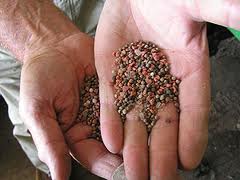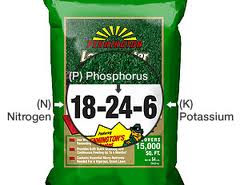 By Joseph Mas
By Joseph Mas
Phosporus (P) is an essential soil nutrient for plant growth and metabolism and is mainly responsible for flowering, fruit growth and root development. It plays key roles in many plant processes such as energy metabolism, the synthesis of nucleic acids and membranes, photosynthesis, respiration, nitrogen uptake and enzyme regulation. Adequate phosphorus nutrition enhances many aspects of plant development and works in conjunction with Nitrogen, and Sulfur.
To maximum efficiency of soil for commercial agriculture, home gardens or lawns it is important to know when to use phosphorus fertilizers and how to manage its usage. In agricultural systems, phosphorus in the harvested crops is removed from the system, resulting in Phosphorus deprived soils if no Phosphorus is supplemented in the form of fertilizer. Fertilizer in the form of rock phosphate or phosphate salts are applied in large quantities each year to soils in the United States.

Phosphorus Pollution
It is important to have you soil tested before applying Phosphor to make sure you have a proper balance of nutrients. According to a study by the American Society of Agronomy many farmers often apply up to four times the phosphate that is removed by the harvest. This practice leads to phosphate pollution of lakes, streams and groundwater. The consequence of Phosphorus pollution in our water sources is an exuberant growth of algae and other aquatic plants in P-polluted water systems, a process known as Eutrophication. That process kills fish and can cause serious imbalances in aquatic ecosystems. In addition, over abundance of Phosphorus in agricultural soil can cause distortion of plant growth by stunting growth and giving plants a deep green hue.
Inorganic phosphorus plays a major role in biological molecules. Plants need phosphate from the soil to make their DNA and RNA.. Phosphorus is one of the 17 nutrients found in healthy soil. Also, it is one of the three nutrients found in synthetic fertilizers: NPK = nitrogen, phosphorus, potassium. It must be taken up by plants – particularly when seedlings and very young – for proper growth. Proper growth depends on cell division, and on growing tips aka meristems. Plants lacking proper amounts of phosphorus will look stunted, from the shoots down through the roots. Phosphates are important to plants as they encourage root growth and so increase the uptake of other nutrients.
 For healthy crops and plants (or lawns) first have an accurate soil sample test performed to determine what fertilizer you may need. When looking for a fertilizer rich in nitrogen, check the middle number labeled on the fertilizer bag. Usually the bags are labeled with numbers such as 13-35-24 or some other combination. The first number is Nitrogen, the second is Phosphorus and the third is Potassium. Fertilizers high in Phosphorus are usually determined by a high middle number. A simple soil test will help determine exactly what is needed to give you the highest yielding crops, most delicious fruits and greenest lawn.
For healthy crops and plants (or lawns) first have an accurate soil sample test performed to determine what fertilizer you may need. When looking for a fertilizer rich in nitrogen, check the middle number labeled on the fertilizer bag. Usually the bags are labeled with numbers such as 13-35-24 or some other combination. The first number is Nitrogen, the second is Phosphorus and the third is Potassium. Fertilizers high in Phosphorus are usually determined by a high middle number. A simple soil test will help determine exactly what is needed to give you the highest yielding crops, most delicious fruits and greenest lawn.
